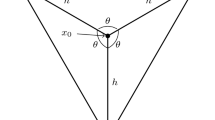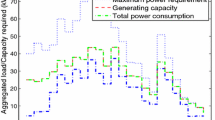Abstract
The purpose of this paper is to present a new steepest edge (SE) approximation scheme for the simplex method. The major advantages are its simplicity of recurrences and implementation, low computational overhead (compared to both the exact SE method and the DEVEX approximation scheme), and surprisingly good performance.
The paper contains a brief account of the exact SE algorithm, the new recurrences developed in the same framework and some discussion on the possible reasons for the method's apparent success. Finally, numerical experiments are presented to assess the practical value of the method. The results are very promising.
Similar content being viewed by others
References
R.H. Bartels and G.H. Golub, "The simplex method of linear programming using LU decomposition," Communication of ACM, vol. 12, pp. 266-268, 1969.
M. Benichou, J.M. Gauthier, G. Hentges, and G. Ribierè "The efficient solution of large-scale linear programming problems- Some algorithmic techniques and computational results," Mathematical Programming, vol 13, pp. 280-322, 1977.
R.E. Bixby, "Progress in linear programming," ORSA J. on Computing, vol. 6, no.1, pp. 15-22, 1994.
W.J. Carolan, J.E. Hill, J.L. Kennington, S. Niemi, and S.J. Wichmann, "An empirical evaluation of the KORBX algorithms for military airlift applications," Operations Research, vol. 38, no.2, pp. 240-248, 1990.
G.B. Dantzig, Linear Programming and Extensions, Princeton, 1963.
J.J. Forrest and D.E. Goldfarb, "Steepest-edge simplex algorithms for linear programming," Mathematical Programming, vol. 57, pp. 341-374, 1992.
K. Frauendorfer, C. Marohn, and M. Schürle, "SG-Portfolio test problems for stochastic multistage linear programming," Technical Report, Inst. of Operations Research, University of St. Gallen, Switzerland, 1995.
D.M. Gay, "Electronic mail distribution of linear programming test problems," Mathematical Programming Society COAL Newsletter, 1985.
D.E. Goldfarb, "On the Bartels-Golub decomposition for linear programming bases," Mathematical Programming, vol. 13, pp. 272-279, 1977.
D.E. Goldfarb and J.K Reid, "A practicable steepest-edge simplex algorithm," Mathematical Programming, vol. 12, pp. 361-371, 1977.
H.J. Greenberg and J.E. Kalan, "An exact update for Harris’ TREAD," Mathematical Programming Study, vol. 4, pp. 26-29, 1975.
P.M.J. Harris, "Pivot selection methods of the DEVEX LP code," Mathematical Programming Study, vol. 4, pp. 30-57, 1975.
J.L. Nazareth, Computer Solution of Linear Programs, Oxford University Press, 1987.
J.K. Reid, "A sparsity-exploiting variant of the Bartels-Golub decomposition for linear programming bases," Mathematical Programming, vol. 24, pp. 55-69, 1982.
A. Świ ętanowski, "A penalty based simplex method for linear programming," Working Paper WP-95-005, International Institute for Applied Systems Analysis, Laxenburg, Austria, 1995.
J.A. Tomlin, "On scaling linear programming problems," Mathematical Programming Study, vol. 4, pp. 146- 166, 1975.
Author information
Authors and Affiliations
Rights and permissions
About this article
Cite this article
Świętanowski, A. A New Steepest Edge Approximation for the Simplex Method for Linear Programming. Computational Optimization and Applications 10, 271–281 (1998). https://doi.org/10.1023/A:1018317206484
Issue Date:
DOI: https://doi.org/10.1023/A:1018317206484




